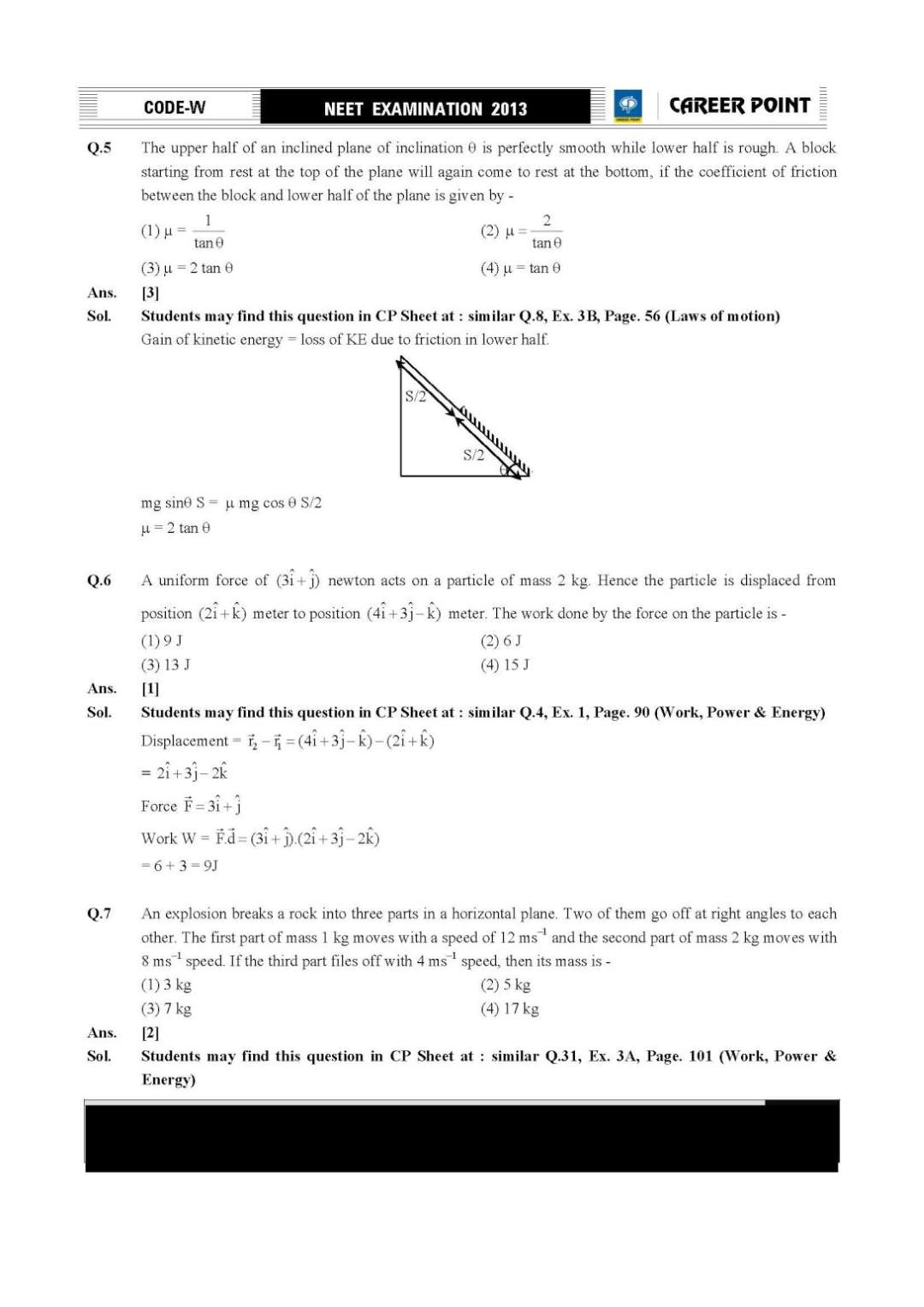|
#2
26th August 2015, 11:09 AM
| |||
| |||
| Re: Question Paper Of AIPMT Pre
This year AIPMT has already conducted on 03-05-2015 (Sunday) 10:00 am. You have to wait for next year. I am still providing you some Questions with a solved paper. The states which take admission to MBBS/BDS seats under AIPMT Score: 1. Haryana 2. Himachal Pradesh 3. Madhya Pradesh 4. Andaman & Nicobar 5. Arunachal Pradesh 6. Manipur 7. Meghalaya 8. Odisha 9. Rajasthan 10. Chandigarh (UT) 11. University of Delhi 12. Armed Forces Medical College (AFMC), Pune 13. Banaras Hindu University, Varanasi (UP) 14. Hamdard University, New Delhi Here I am providing you some Questions for Practice. For more Questions you have to download the file in the attachment. Q.1 In an experiment four quantities a, b, c and d are measured with percentage error 1%, 2%, 3% and 4% respectively. Quantity P is calculated as follows : P =cdb a 2 3. % error in P is – (1) 14% (2) 10% (3) 7% (4) 4% Q.2 The velocity of a projectile at the initial point A is ) jˆ 3 iˆ2 ( + m/s. It's velocity (in m/s) at point B is - YX BA (1) jˆ 3 iˆ2 − − (2) jˆ 3 iˆ2 + − (3) jˆ 3 iˆ2 − (4) jˆ 3 iˆ2 + Q.3 A stone falls freely under gravity. It covers distances h1, h2 and h3 in the first 5 seconds, the next 5 seconds and the next 5 seconds respectively. The relation between h1, h2 and h3 is – (1) h1 = 2h2 = 3h3 (2) h1 = 5h3h 3 2 = (3) h2 = 3h1 and h3 = 3h2 (4) h1 = h2 = h3 Q.4 Three blocks with masses m, 2m and 3m are connected by strings, as shown in the figure. After an upward force F is applied on block m, the masses move upward at constant speed v. What is the net force on the block of mass 2m ? (g is the acceleration due to gravity) 3m 2m m F v (1) zero (2) 2 mg (3) 3 mg (4) 6 mg Q.5 The upper half of an inclined plane of inclination θ is perfectly smooth while lower half is rough. A block starting from rest at the top of the plane will again come to rest at the bottom, if the coefficient of friction between the block and lower half of the plane is given by – (1) µ =θ tan1 (2)θ= µtan2 (3) µ = 2 tan θ (4) µ = tan θ Q.6 A uniform force of ) jˆ iˆ3 ( + newton acts on a particle of mass 2 kg. Hence the particle is displaced from position ) kˆiˆ2 ( + meter to position ) kˆ jˆ 3 iˆ4 ( − + meter. The work done by the force on the particle is – (1) 9 J (2) 6 J (3) 13 J (4) 15 J Q.7 An explosion breaks a rock into three parts in a horizontal plane. Two of them go off at right angles to each other. The first part of mass 1 kg moves with a speed of 12 ms–1 and the second part of mass 2 kg moves with 8 ms–1 speed. If the third part files off with 4 ms–1 speed, then its mass is – (1) 3 kg (2) 5 kg (3) 7 kg (4) 17 kg Q.8 A rod PQ of mass M and length L is hinged at end P. The rod is kept horizontal by a massless string tied to point Q as shown in figure. When string is cut, the initial angular acceleration of the rod is –PQLM (1) L 2g 3 (2)Lg (3)Lg 2 (4)L 3g 2 Q.9 A small object of uniform density rolls up a curved surface with an initially velocity 'v'. It reaches upto a maximum height of g 4v 3 2with respect to the initial position. The object is – (1) Ring (2) Solid sphere (3) Hollow sphere (4) Disc Q.10 A body of mass 'm' is taken from the earth's surface to the height equal to twice the radius (R) of the earth. The change in potential energy of body will be – (1) mg 2R (2) 32 mgR (3) 3 mgR (4) 31 mgR Q.12 The following four wires are made of the same material. Which of these will have the largest extension when the same tension is applied ? (1) length = 50 cm, diameter = 0.5 mm (2) length = 100 cm, diameter = 1 mm (3) length = 200 cm, diameter = 2 mm (4) length = 300 cm, diameter = 3 mm Q.13 The wettability of a surface by a liquid depends primarily on – (1) viscosity (2) surface tension (3) density (4) angle of contact between the surface and the liquid Q.14 A piece of iron is heated in a flame. It first becomes dull red then becomes reddish yellow and finally turns to white hot. The correct explanation for the above observation is possible by using – (1) Stefan's law (2) Wien's displacement law (3) Kirchoff's law (4) Newton's law of cooling    |